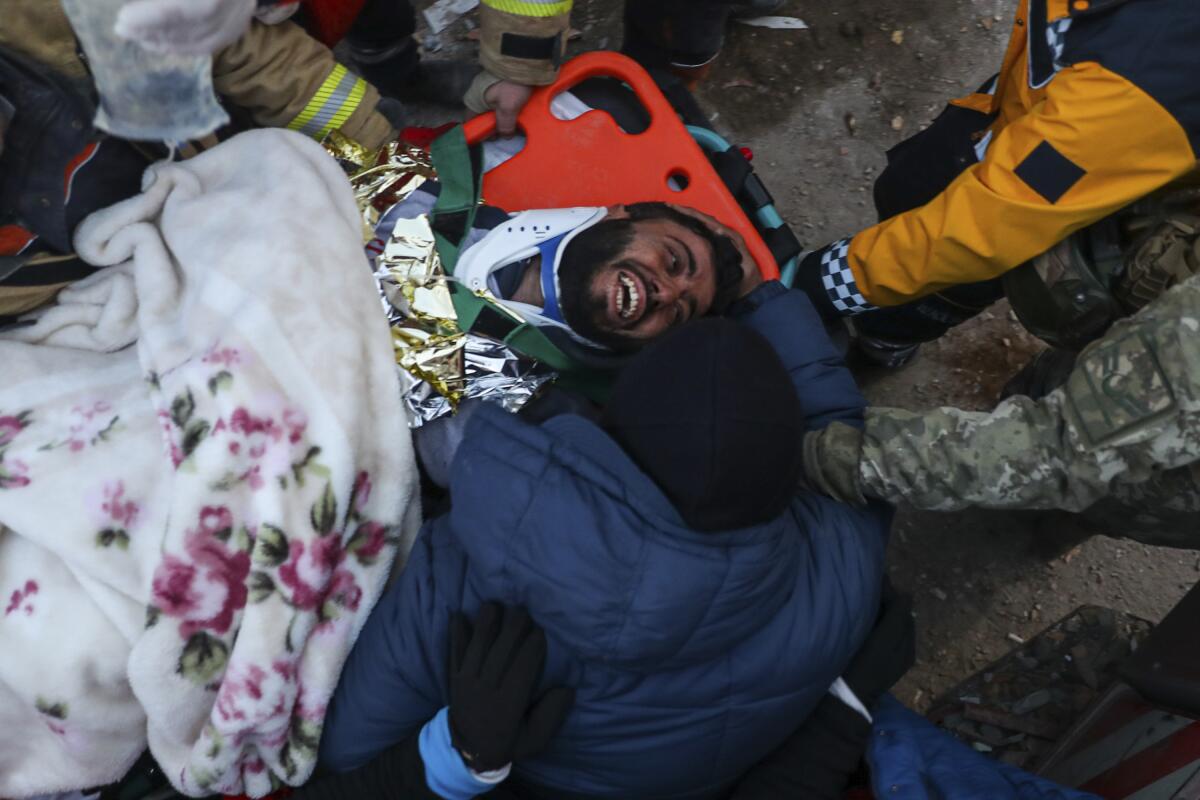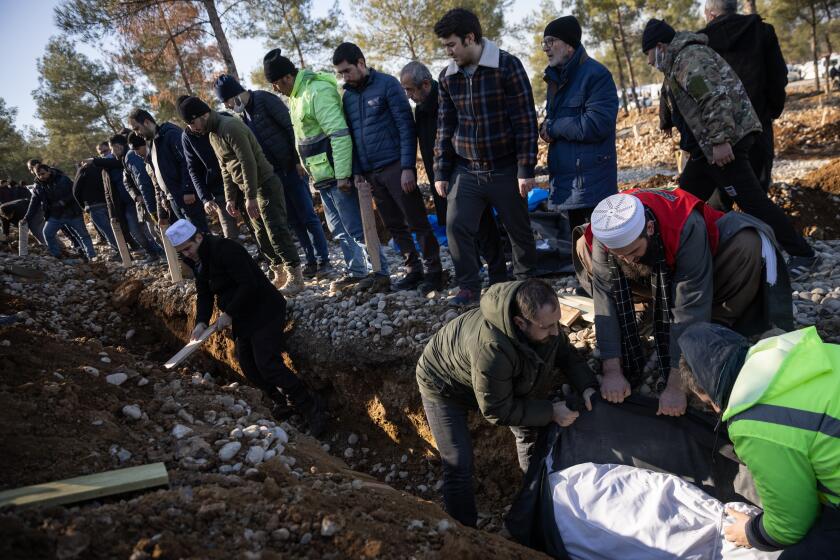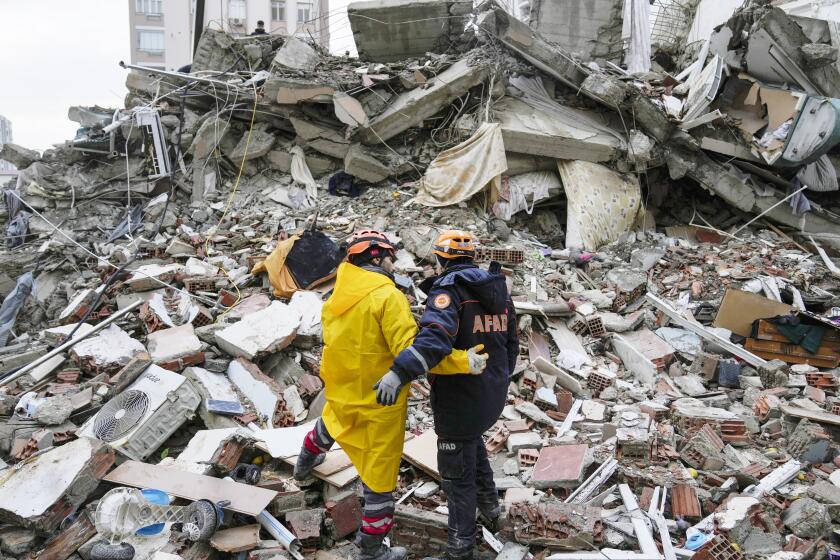Survivors in Turkey still being found 5 days after quake, as death toll tops 28,000

ANTAKYA, Turkey — Rescue crews in Turkey on Saturday pulled more survivors, including entire families, from toppled buildings despite diminishing hopes as the death toll of last week’s enormous quake that struck a border region of Turkey and Syria surpassed 28,000.
Dramatic rescues were being broadcast on Turkish television, including the rescue of the Narli family in central Kahramanmaras 133 hours after the quake struck early Monday. First, 12-year-old Nehir Naz Narli was saved, then both parents.
That followed the rescue earlier in the day of a family of five from a mound of debris in the hard-hit town of Nurdagi, in Gaziantep province, TV network HaberTurk reported. Rescuers cheered and chanted, “God is great!” as the last family member, the father, was lifted to safety.
Excavators dig out 200-foot trenches in southern Turkey to bury the bodies of earthquake victims. The death toll rises to more than 20,000.
Turkish President Recep Tayyip Erdogan continued his tour of quake-stricken cities on Saturday.
The total death toll in Syria’s northwestern rebel-held region has reached 2,166, according to the Syrian Civil Defense, a volunteer emergency aid group in the area known as the White Helmets. The overall death toll in Syria stood at 3,553 on Saturday, though the 1,387 deaths reported for government-held parts of the country hasn’t been updated in days.
Erdogan said the scope of the disaster was rare, both in terms of the size of the affected area and the number of people living there.
He called the earthquake the “disaster of the century” and said it had affected an area 310 miles in diameter that is home to 13.5 million people in Turkey and an unknown number in Syria.
“In some parts of our settlements close to the fault line, we can say that almost no stone was left standing,” he said Saturday from
Diyarbakir.
Still, the day brought one astonishing rescue after another, numbering more than a dozen.
Melisa Ulku, a woman in her 20s, was extricated from the rubble in Elbistan in the 132nd hour since the quake, following the rescue of another person at the same site in the same hour. She was covered in a thermal blanket on a stretcher. Rescuers were hugging. Some shouted, “God is great!”
An hour earlier, a 3-year-old girl and her father were pulled from debris in the town of Islahiye in Gaziantep province, and soon after a 7-year-old girl was rescued in the province of Hatay.
The rescues brought shimmers of joy amid overwhelming devastation days after Monday’s magnitude 7.8 quake and a powerful aftershock hours later caused thousands of buildings to collapse. Along with the people who were killed, more than 80,000 were injured and millions were left homeless.
The search operations also produced searing disappointments. Rescuers reached a 13-year-old girl inside the debris of a collapsed building in Hatay province early Saturday and intubated her. But she died before the medical teams could amputate a limb and free her from the rubble, Hurriyet newspaper reported.
Although experts say trapped people can live for a week or more, the odds of finding more survivors were quickly waning. Rescuers were shifting to thermal cameras to help identify life amid the rubble.
As aid continued to arrive, a 99-member group from the Indian army’s medical assistance team began treating injured people in a temporary field hospital in the southern city of Iskenderun, where a main hospital was demolished.
One man, Sukru Canbulat, was wheeled into the hospital in a wheelchair, his left leg badly injured with deep bruising and cuts.
Wincing in pain, he said he had been rescued from his collapsed apartment building in the nearby city of Antakya within hours of the quake. But after receiving basic first aid, he was released without getting proper treatment for his injuries.
“I buried [everyone that I lost], then I came here,” Canbulat said, counting his dead relatives: “My daughter is dead, my sibling died, my aunt and her daughter died, and the wife of her son” who was 8½ months pregnant.
A large makeshift graveyard was under construction on the outskirts of Antakya on Saturday. Backhoes and bulldozers dug pits in the field on the northeastern edge of the city as trucks and ambulances loaded with black body bags arrived continuously. Soldiers directing traffic on the adjacent road warned motorists not to take photographs.
The hundreds of graves were marked with simple wooden planks set vertically in the ground.
A worker with Turkey’s Ministry of Religious Affairs who did not wish to be identified because of orders not to share information with the media said that about 800 bodies were brought to the cemetery Friday, its first day of operation. By midday Saturday, he said, as many as 2,000 had been buried.
Temperatures remained below freezing across the region, and many people have no shelter. The Turkish government has distributed millions of hot meals, as well as tents and blankets, but is still struggling to reach many people in need.
The flaws of non-ductile concrete construction are found across California, with many buildings having not been evaluated or retrofitted and at risk of collapse in a serious earthquake.
Temperatures remained below freezing across the large region, and many people have no shelter. The Turkish government has distributed millions of hot meals, as well as tents and blankets, but is still struggling to reach many people in need.
The disaster compounded suffering in a region beset by Syria’s 12-year civil war, which has displaced millions of people within the country and left them dependent on aid. The fighting sent millions more to seek refuge in Turkey.
The conflict has isolated many areas of Syria and complicated efforts to get aid in. The United Nations said the first earthquake-related aid convoy crossed from Turkey into northwestern Syria on Friday.
The United Nations refugee agency estimated that as many as 5.3 million people have been left homeless in Syria.
Syrian President Bashar Assad and his wife have visited injured quake victims in a hospital in the coastal city of Latakia.
Syrian state TV said Assad and his wife, Asma, on Saturday morning visited Duha Nurallah, 60, and her son Ibrahim Zakariya, 22, who were pulled out the night before from under the rubble of a building in the coastal town of Jableh.
The head of the World Health Organization, Tedros Adhanom Ghebreyesus, arrived in Syria’s northern city of Aleppo on Saturday, bringing with him 35 tons of medical equipment, state news agency SANA reported. He said another plane carrying an additional 30 tons of medical equipment will arrive in the coming days.
The Syrian Civil Defense said Saturday that it “is almost impossible to find people alive.”
More to Read
Sign up for Essential California
The most important California stories and recommendations in your inbox every morning.
You may occasionally receive promotional content from the Los Angeles Times.












